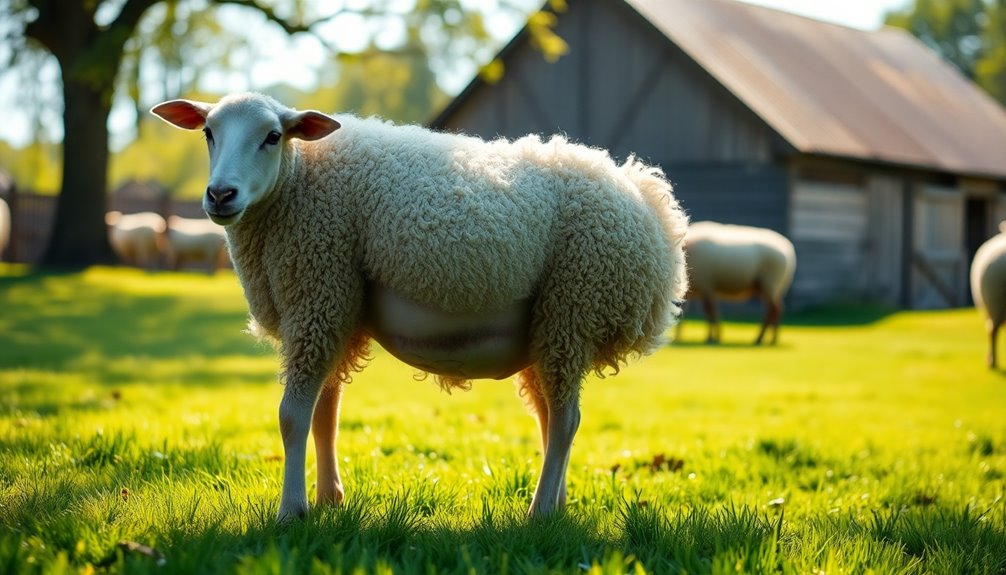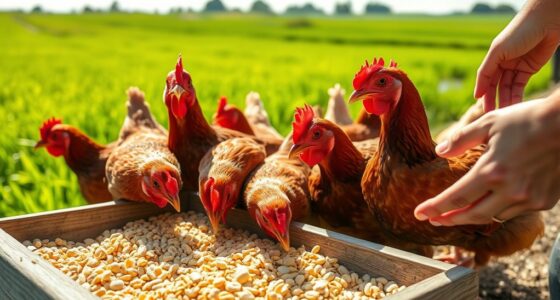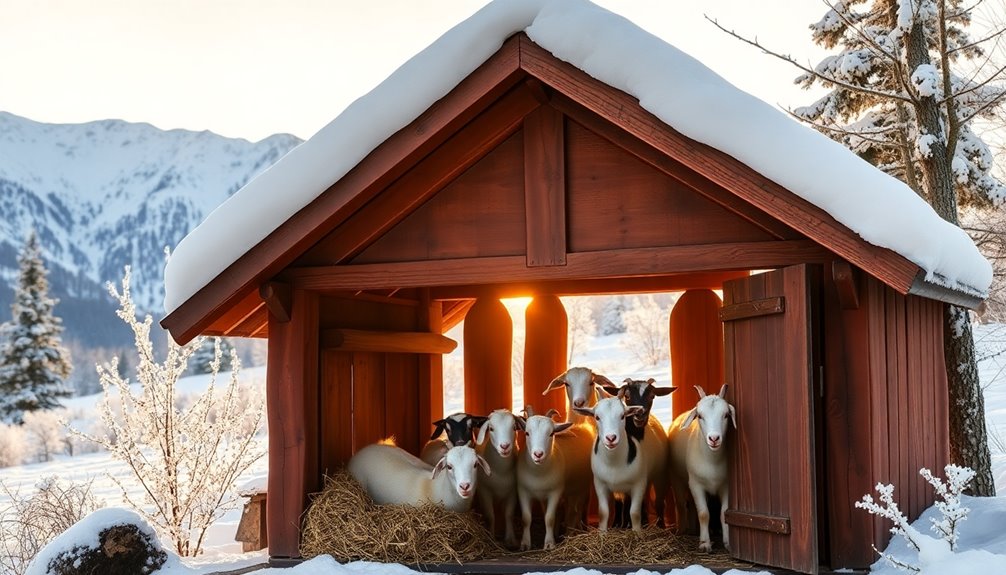Yes, sheep and goats can live together, but it comes with both advantages and challenges. Different foraging habits lead to better pasture health, while their companionship can reduce stress. However, goats' boisterous nature may harm sheep, and they require stronger fencing. Managing dietary needs and health can be complex. To ensure a successful mixed herd, consider effective management strategies. Continue exploring to uncover more insights on this topic and how to navigate the challenges.
Key Takeaways
- Sheep and goats have different grazing habits, which can enhance pasture health but complicate feeding strategies.
- Goats may be aggressive towards sheep, potentially leading to injuries and conflicts in a mixed herd.
- Stronger fencing is necessary to contain goats, as they are more prone to escaping and damaging fences.
- Both species can share diseases, increasing veterinary costs and complicating health management.
- Co-habitation can reduce stress and promote companionship, improving overall health and farm productivity when managed properly.
Feasibility of Co-Habitation
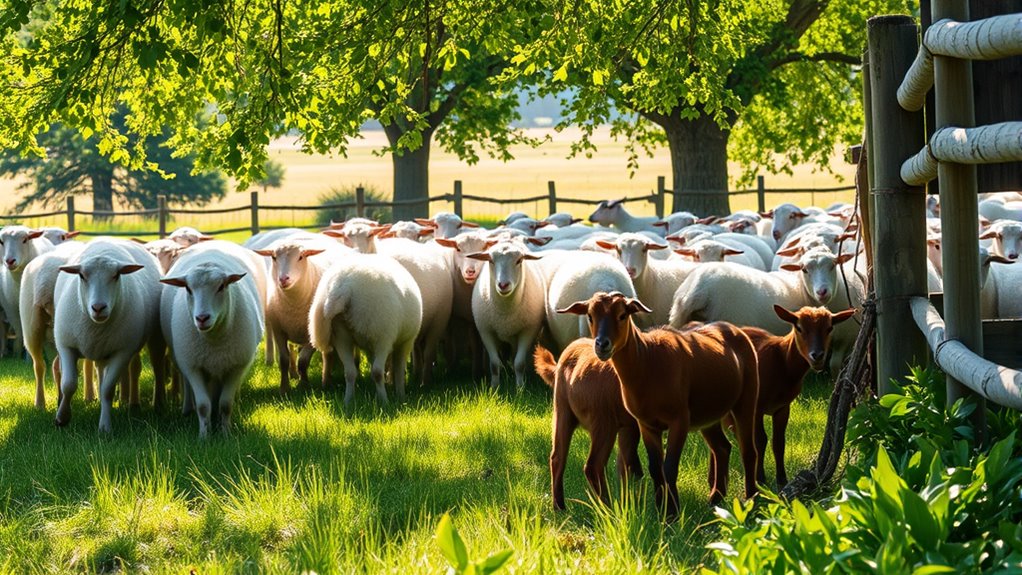
While you might consider keeping sheep and goats together, the feasibility of co-habitation involves several important factors.
First, you'll need to manage parasites effectively, as goats are more vulnerable to worms and flukes. Behavioral differences also play a role; goats are often more boisterous, which can harm sheep. Stronger fencing is essential for goats due to their jumping ability.
Managing parasites and providing strong fencing are crucial when keeping goats and sheep together.
Additionally, their grazing habits differ: sheep graze while goats browse, impacting pasture management. Both species have unique dietary needs and social requirements, which can lead to interaction challenges.
To ensure a successful co-habitation, you'll need to monitor their behaviors and provide adequate space, balancing their nutritional requirements while keeping costs manageable.
Pros of Keeping Sheep and Goats Together

Keeping sheep and goats together can offer numerous advantages for farmers, especially when it comes to enhancing farm productivity and promoting a healthy ecosystem.
Their different foraging habits allow for diverse plant consumption, leading to healthier pastures and reduced chemical use. You'll notice improved land efficiency as they complement each other's grazing patterns without overgrazing.
This natural approach not only boosts plant species variety but also saves you money on feed and chemicals. Additionally, the companionship between the two species reduces stress, contributing to better overall health.
Their combined presence can even aid in natural pest control, creating a more balanced environment on your farm. Ultimately, this cohabitation can lead to increased milk and meat production, enhancing your farm's output.
Cons of Keeping Sheep and Goats Together
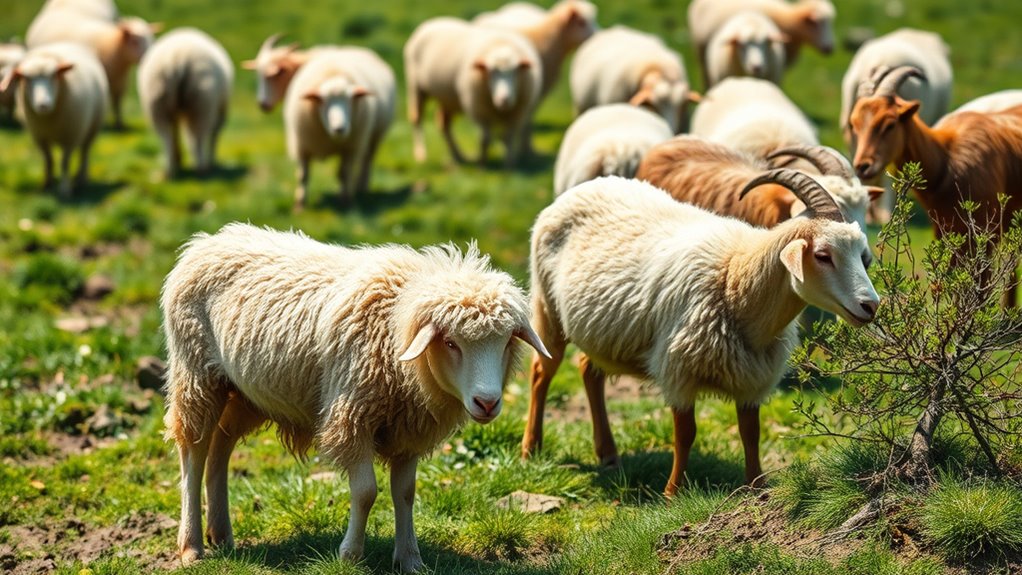
When considering the cons of keeping sheep and goats together, it's important to recognize the challenges that can arise from their differing behaviors and needs.
Goats are notorious for escaping and can damage fences, requiring you to invest in sturdier fencing and regular maintenance. Their more aggressive nature might unintentionally harm sheep, leading to conflicts and stress among the herd.
Moreover, their dietary preferences differ significantly; while sheep graze, goats browse, complicating feeding strategies. This complexity also extends to disease management, as both species can share illnesses, increasing your veterinary costs.
Health Considerations for Mixed Herds

Managing a mixed herd of sheep and goats presents unique health challenges that require careful attention. Both species can share diseases like footrot and internal parasites, so it's crucial to keep your herd disease-free.
Quarantine new animals to prevent introducing illnesses. Tailor your vaccination programs to meet the specific needs of your herd, focusing on clostridial vaccines for both.
Internal parasites can be a concern, especially with goats, so implement rotational grazing and strategic deworming to manage loads effectively. Additionally, ensure that you provide adequate space to reduce competition for resources, as this can help maintain overall health.
Don't forget that stress can weaken their immune systems, so prioritize proper shelter and minimize stressors.
Consulting a veterinarian will help you create a comprehensive health plan for your mixed herd.
Environmental Impact of Mixed Grazing
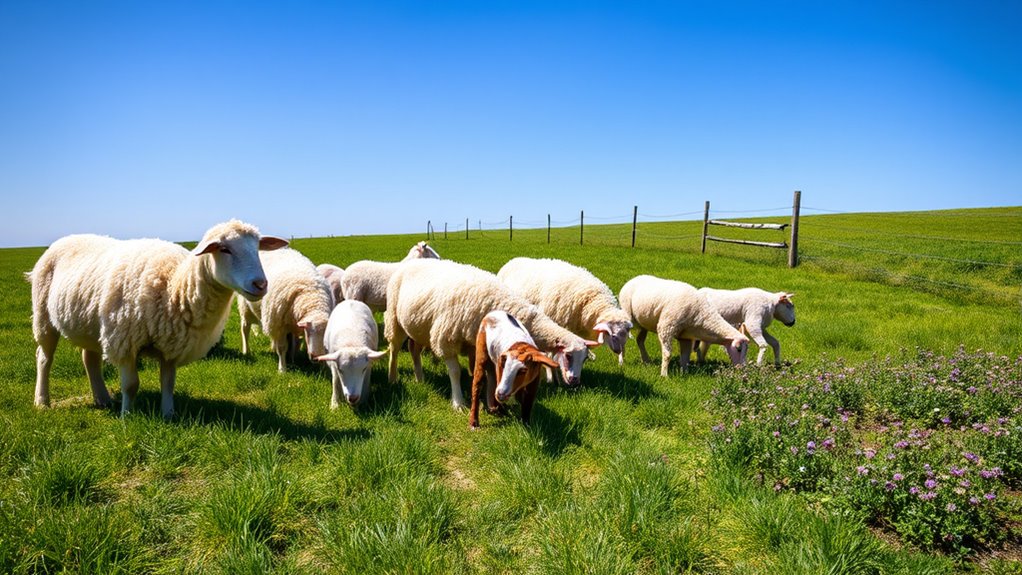
Mixed grazing of sheep and goats can significantly impact the environment, both positively and negatively.
When managed well, this practice can enhance biodiversity by controlling invasive species and maintaining native plant diversity. However, if overgrazing occurs, you risk soil erosion and reduced vegetative cover, leading to ecosystem degradation.
Both species emit methane, contributing to climate change, while grazing can also affect water quality through increased runoff.
To mitigate these issues, consider rotational grazing and low-intensity practices, which help maintain soil health and ecosystem services.
Ultimately, the environmental impact hinges on your management choices, emphasizing the need for careful planning to balance productivity with ecological health.
Management Strategies for Successful Co-Habitation

Successful co-habitation of sheep and goats requires careful planning and management to ensure both species thrive together.
First, invest in strong, secure fencing that's goat-proof to keep both animals contained; regular inspections are essential to fix weak points.
Nutrition is key: separate feeding areas help meet each species' dietary needs, as sheep prefer grasses and goats enjoy browsing. Offer high-quality hay and ensure fresh water is always available.
For shelter, provide a clean, dry space that meets goats' needs while protecting sheep from extreme weather.
Finally, monitor health closely with regular vet check-ups and vaccinations. Introduce the animals gradually to foster harmony, and ensure ample space to minimize stress and promote a peaceful environment.
Behavioral Differences Between Sheep and Goats
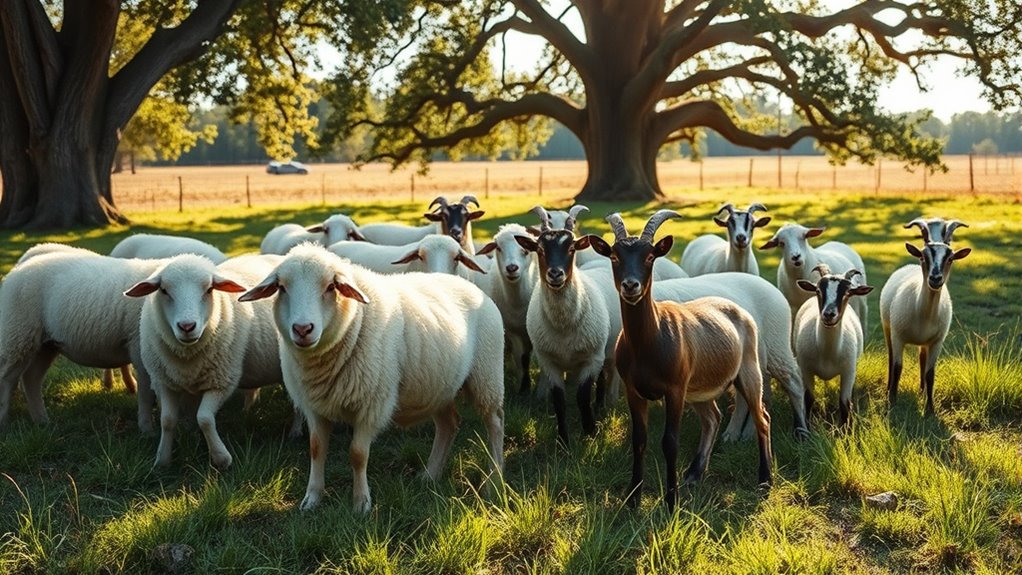
Understanding the behavioral differences between sheep and goats is key to fostering a harmonious environment for both species. Sheep are highly social and prefer to flock together, while goats are more independent and curious.
When threatened, sheep huddle close, but goats tend to scatter and climb to escape. Their dietary habits also differ; sheep graze on grasses, whereas goats browse on leaves and shrubs.
You'll find that sheep are generally docile and easier to handle, while goats require more individualized training due to their boisterous nature. Additionally, goats need more space to explore, making it essential to manage their environment carefully to prevent conflicts and ensure both species thrive together.
Economic Benefits of Mixed Farming

When you combine sheep and goats in your farming operation, you unlock a range of economic benefits that can boost your bottom line.
With diverse income streams from meat, milk, wool, and fiber, you can tap into various markets, including health-conscious consumers and ethnic groups.
Lower start-up costs make it feasible for small-scale farmers like you to enter the livestock business.
You'll also benefit from increased stocking rates on pastures and reduced maintenance needs.
Additionally, your products can gain export potential, enhancing profitability.
By managing your land wisely, you can improve soil health and control weeds effectively.
Ultimately, this mixed farming approach can lead to greater financial stability and resilience against market fluctuations. Furthermore, the integration of livestock can enhance soil health through natural fertilization, reducing the need for synthetic inputs.
Frequently Asked Questions
What Breeds of Sheep and Goats Are Best for Co-Habitation?
When you're considering co-habitation, Icelandic and Katahdin sheep are excellent choices due to their copper tolerance.
For goats, Pygmy goats work well because of their small size and friendly nature.
These breeds can complement each other's grazing and browsing habits.
Just remember, you'll need to manage their different dietary needs and ensure good fencing.
Keeping both species healthy and safe is crucial for a harmonious environment in mixed herds.
How Can I Identify if My Animals Are Stressed Together?
How can you tell if your animals are stressed living together? Look for signs like excessive vocalization, changes in appetite, or increased grooming.
You might notice aggression or social withdrawal, too. Physical signs like trembling or panting can indicate anxiety.
If you see inappropriate elimination or disrupted sleep patterns, it's a red flag. Keeping a close watch on these behaviors helps you manage their stress effectively and create a harmonious environment.
What Are the Signs of Disease in Sheep and Goats?
When you're monitoring your sheep and goats, look for signs of disease. If an animal isolates itself, eats abnormally, or shows depression, that's a red flag.
You should also watch for respiratory issues like coughing or difficulty breathing. Diarrhea, dehydration, and weakness indicate gastrointestinal problems. Skin lesions or sores around the mouth can signal infections.
Staying vigilant about these symptoms helps you maintain their health and well-being. Don't ignore the warning signs!
Can Mixed Grazing Affect the Growth of Certain Plants?
Yes, mixed grazing can significantly affect the growth of certain plants.
When you introduce different herbivores, they tend to consume various parts of plants, which promotes a healthier ecosystem. This diversity helps maintain nutrient cycling, enhancing nitrogen and phosphorus levels in plants.
Additionally, mixed grazing can reduce overgrazing and improve grassland diversity, allowing more palatable species to thrive while limiting the dominance of less desirable plants in your pasture.
Do Sheep and Goats Require Different Housing Styles?
Did you know that adult sheep need about 1.5 square meters of space each, while pregnant ewes need up to 2 square meters?
You'll find that sheep and goats do require different housing styles. Sheep can thrive with minimal shelter, thanks to their wool, but goats need sturdier protection, especially from harsh weather.
Additionally, goats are trickier to fence in, so you'll need to consider those differences when planning their housing.
Conclusion
In conclusion, keeping sheep and goats together can be a rewarding venture, offering companionship in the pasture, diverse grazing, and shared resources. However, it requires careful management, awareness of their differences, and a commitment to their health. By balancing the benefits of mixed herding with the challenges of cohabitation, you can create a thriving environment where both species flourish, roam freely, and contribute to a vibrant farm life full of harmony and productivity.



